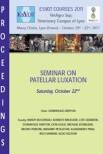Objective—To investigate effects of 1% hyaluronic acid–chondroitin sulfate–N-acetyl glucosamine (HCNAG) on the damage repair response in equine articular cartilage.
Sample—Articular cartilage from 9 clinically normal adult horses.
Procedures—Full-thickness cartilage disks were harvested from the third metacarpal bone. Cartilage was single-impact loaded (SIL) with 0.175 J at 0.7 m/s and cultured in DMEM plus 1 % (vol/vol) HCNAG or fibroblastic growth factor (FGF)-2 (50 ng/mL). Histologic and immunohistochemical techniques were used to identify tissue architecture and apoptotic cells and to immunolocalize type I and II collagen and proliferating nuclear cell antigen (PCNA).
Results—Type II collagen immunoreactivity increased in SIL cartilage, compared with control samples. At days 14 and 28 (day 0 = initiation of culture), control samples had significantly fewer repair cells than did other treatment groups. In control samples and SIL + HCNAG, there was a significant decrease in apoptotic cell number, compared with results for SIL and SIL + FGF-2 samples. At days 14 and 28, there was a significant increase in chondrocytes stained positive for PCNA in the control samples.
Conclusions and Clinical Relevance—1% HCNAG significantly affected apoptotic and repair cell numbers in an SIL damage-repair technique in adult equine articular cartilage. However, HCNAG had no effect on the number of PCNA-positive chondrocytes or on type II collagen immunohistochemical results. The inclusion of 1% HCNAG in lavage solutions administered after arthroscopy may be beneficial to cartilage health by increasing the number of repair cells and decreasing the number of apoptotic cells.









